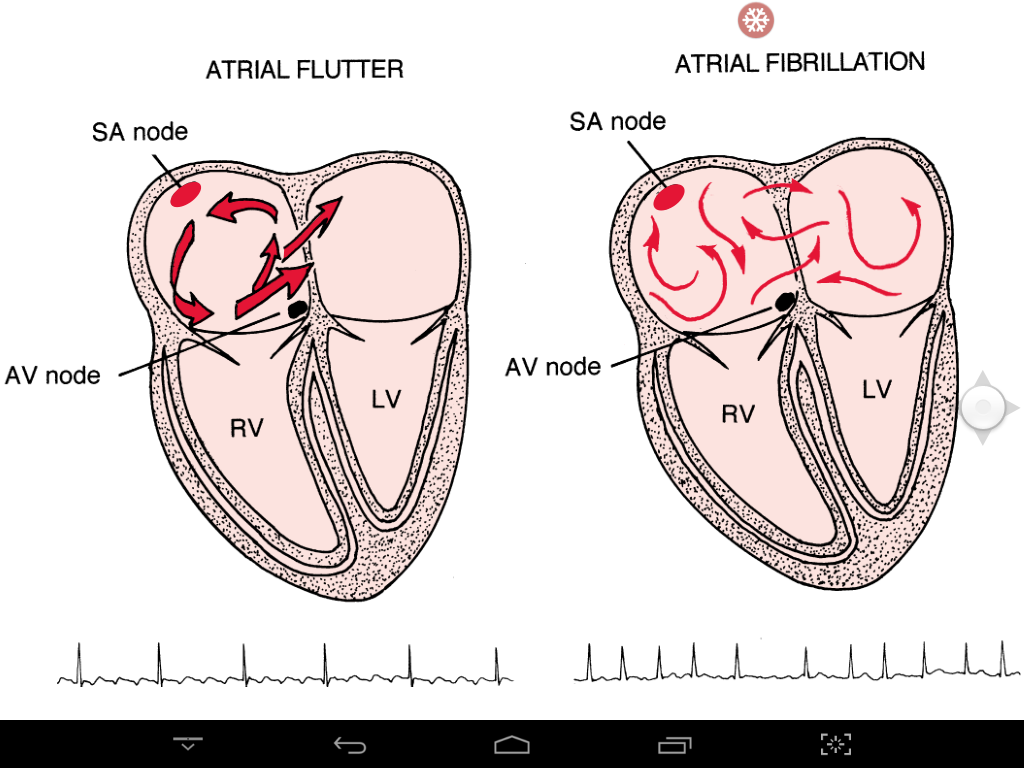
A classification of atrial flutter and regular atrial tachycardia according to electrophysiological mechanisms and anatomical bases a statement from a joint expert group from the Working Group of Arrhythmias of the European Society of Cardiology and the North American Society of Pacing and Electrophysiology. 2015 ACC/AHA/HRS guideline for the management of adult patients with supraventricular tachycardia. This rhythm is closely related to atrial fibrillation.


: Typical atrial flutter with variable (3 to 4:1) block From the collection of Dr K.C. ACC/AHA/Physician Consortium 2008 clinical performance measures for adults with nonvalvular atrial fibrillation or atrial flutter. Estes NA 3rd, Halperin JL, Calkins H, et al American College of Cardiology American Heart Association Task Force on Performance Measures Physician Consortium for Performance Improvement. Characteristic features on ECG are negatively directed saw-tooth atrial deflections (f waves) seen in leads II, III, and aVF, with positively directed deflections in lead V1.
Atrial flutter atrial fibrillation free#
The term anticlockwise refers to the direction of activation when the tricuspid annulus is viewed en face, whereby activation occurs up the septum, down the right atrial free wall in an anticlockwise fashion. The typical form depends on the so-called cavotricuspid isthmus for part of the circuit: tricuspid annulus as the anterior boundary and the crista terminalis/eustachian ridge as the posterior boundary, as well as the endocardial cavity of the right atrium. It results from organised electrical activity in which large areas of the atrium take part in the re-entrant circuit. Typical atrial flutter (anticlockwise cavotricuspid isthmus-dependent atrial flutter) is a macro re-entrant atrial tachycardia with atrial rates usually above 250 bpm up to 320 bpm. If electrical cardioversion is unavailable or not acceptable to the patient, pharmacological cardioversion may be attempted. If the rhythm persists in a haemodynamically stable patient, despite rate control and treatment of the underlying cause (or in the absence of a reversible cause), electrical cardioversion is used to terminate the arrhythmia. If a patient is haemodynamically stable, the first-line treatment is rate control and management of the underlying cause. If a patient is haemodynamically unstable, they should be given emergency electrical cardioversion. Because of alterations in atrial activation, the ECG often fluctuates between both rhythms in the same patient. Atrial fibrillation may also convert to atrial flutter. This rhythm is commonly associated with atrial fibrillation, into which it may degenerate. Ventricular rates range from 120 to 160 bpm, and most characteristically 150 bpm, because an associated 2:1 atrioventricular block is common. But over time, atrial flutter often returns since cardioversion alone does not correct the underlying causes of an abnormal heart rhythm.Atrial flutter is typically characterised on the ECG by flutter waves, which are a saw-tooth pattern of atrial activation, most prominent in leads II, III, aVF, and V1.Ītrial rates are typically above 250 bpm and up to 320 bpm. This commonly will restore your normal heart rhythm. electrical cardioversion therapy, which involves using a special machine to send electrical energy to the heart muscle.Medication alone is successful in 20 to 30 percent of people with atrial flutter. medication to control your heart rhythm.Other treatment options for atrial flutter include: With atypical atrial flutter, cardiac ablation is successful for 60 to 70 percent of patients, since additional scarring in the heart chamber may develop over time and cause different atypical atrial flutters. But it is unlikely you will need general anesthesia requiring the use of a ventilator.Ĭardiac ablation is very effective for people with typical atrial flutter, providing a cure for 90 percent of these patients. This procedure uses heat energy or cold energy to destroy a small area of heart tissue that is causing the atrial flutter. Cardiac Ablationĭuring a cardiac ablation, we will insert thin, flexible tubes into your groin and guide them to the affected area.

We will develop a detailed treatment plan for you, which may include one or more of the therapies below. Our heart specialists have extensive experience in treating people with atrial flutter and AFib. If not, your doctor may recommend treatment. Sometimes atrial flutter goes away by itself.


 0 kommentar(er)
0 kommentar(er)
